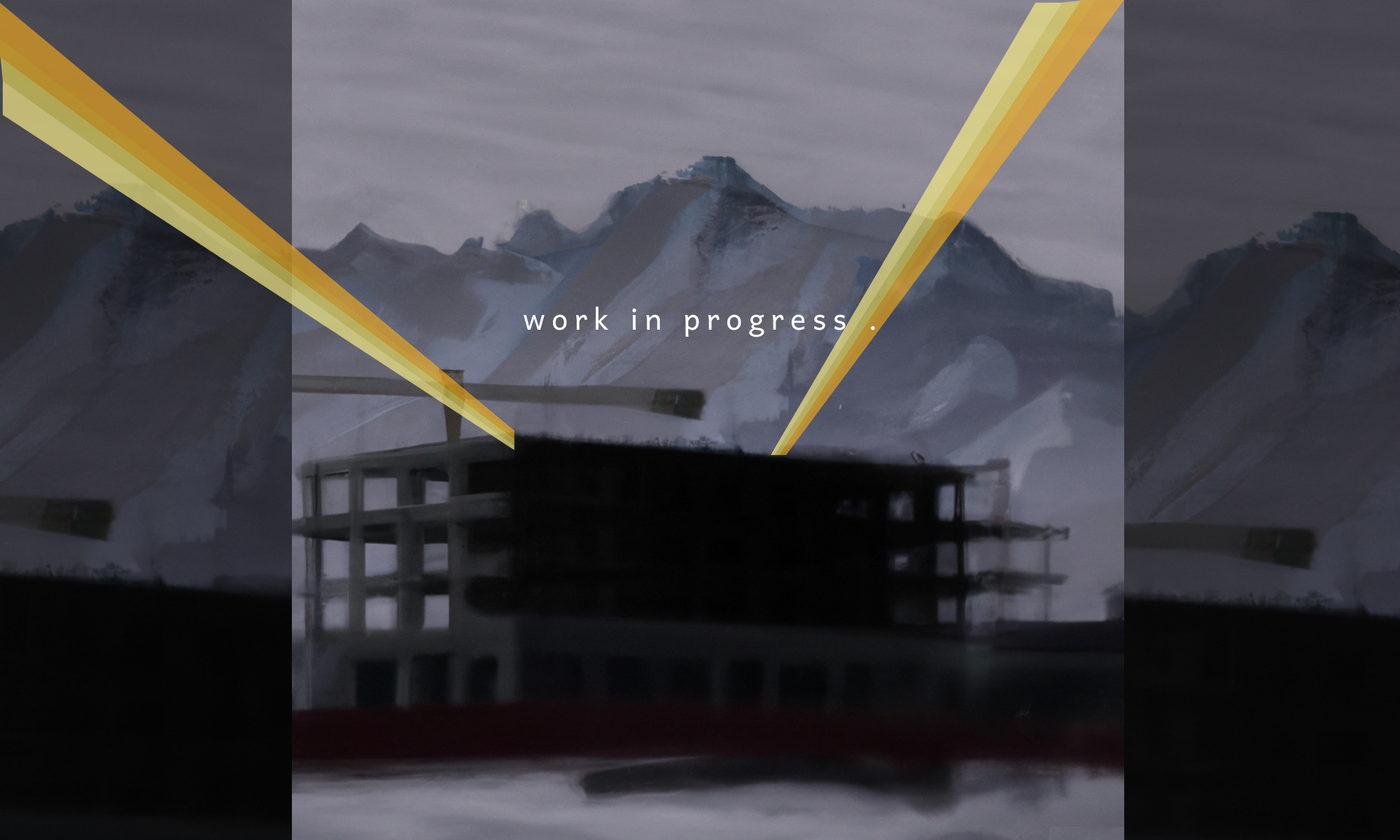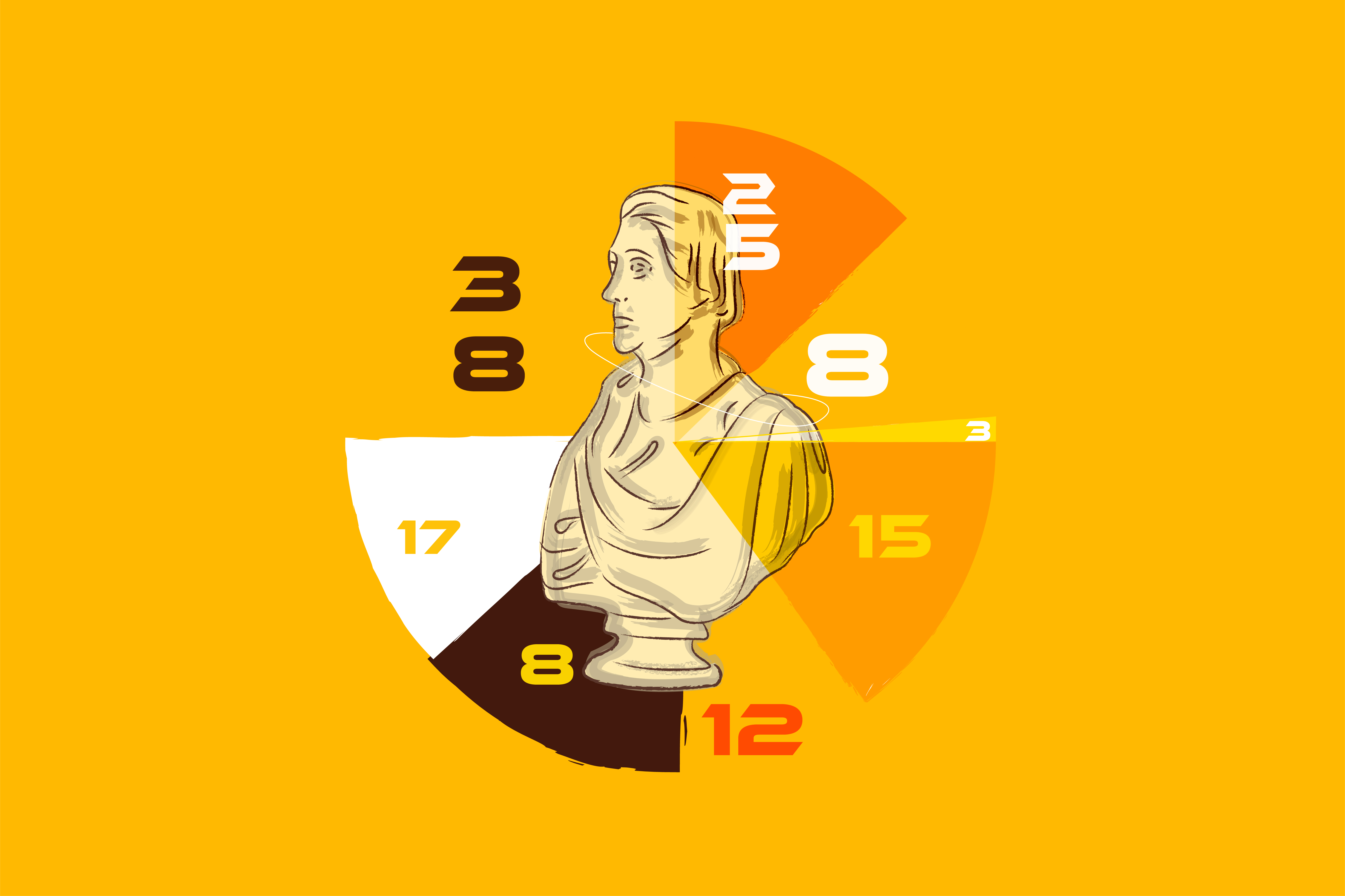Annual Report is a comprehensive document outlining the activities of an establishment. Every IIT releases an annual report outlining budgetary allocation, achievements and activities of the institute. Sounds boring right? Watch Out! brings to you a crisp and easy-to-read analysis of the available annual reports of IIT Roorkee and other IITs. The annual report for the years after 2019-20 have not been released and hence have not been included.
These reports are available at: Annual Reports Of IIT Roorkee (If the website does not open, try going to Advanced Options, proceed anyways)
Our annual report analysis is a small compilation of relevant information filtered from hundreds of pages of ruthlessly complex content. It is fragmented into funding and grants to get an idea of the allocated finances and where it is spent. In the next section, we deal with the student-to-professor ratios and their implications. Lastly, we look at the workings of international relations and the recent trend regarding our outbound and inbound students.
Section 1: Funding and Grants
The Ministry of Human Resource and Development(MHRD), now renamed the Ministry of Education (MoE), provides funding in the form of grants to various IITs and Centrally Funded Technical Institutes.
1. Year on Year comparison of the MHRD grants.
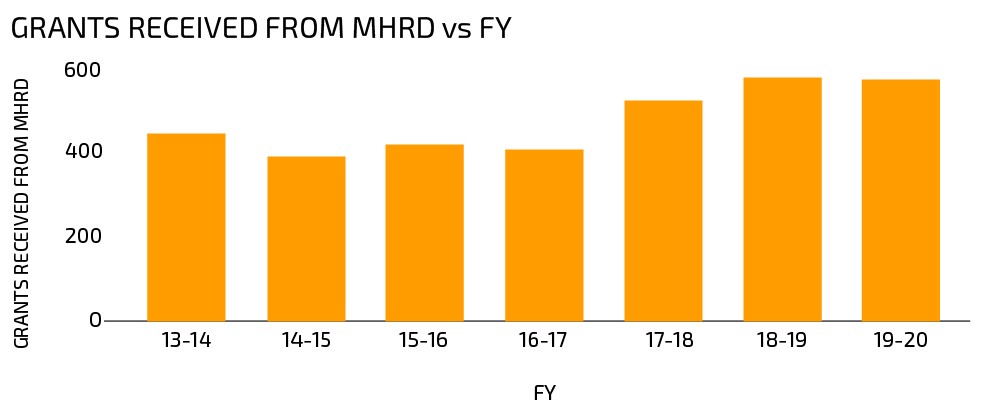
- It is observed that the grants received were fairly constant till FY 2016-17 and after that they have been increasing from FY 2016-17 to FY 2019-20.
- The Compounded Annual Growth Rate (CAGR) of these grants is around 6.36%, which is comparable with what other IITS get.
- The MHRD grants are well in line with the budget allocation on education, the drastic rise in the year 17-18 is due to the 10% rise in education budget. In the financial years of 18-19 and 19-20, the education budget more or less remained flat, which is reflected in the MHRD grants for both the FYs.
- For a global context with respect to the funding of IITs, Stanford, a private university in the United States, has an annual budget of 50,000 crore INR while it’s around 25,000 crores on average for the Chinese state universities. Whereas the collective budget of all IITs stands around 8100 crores. These large disparities in the funding of the institutes puts the availability of resources into perspective.
2. Comparing MHRD grants to other IITs:
Based on the total amount of grants received in FY 19-20 it can be concluded that the top ranked IITs receive a similar amount of funding with IIT Delhi receiving the highest funding. IIT Kharagpur, being an outlier because of its size and area, wasn’t included in this analysis.
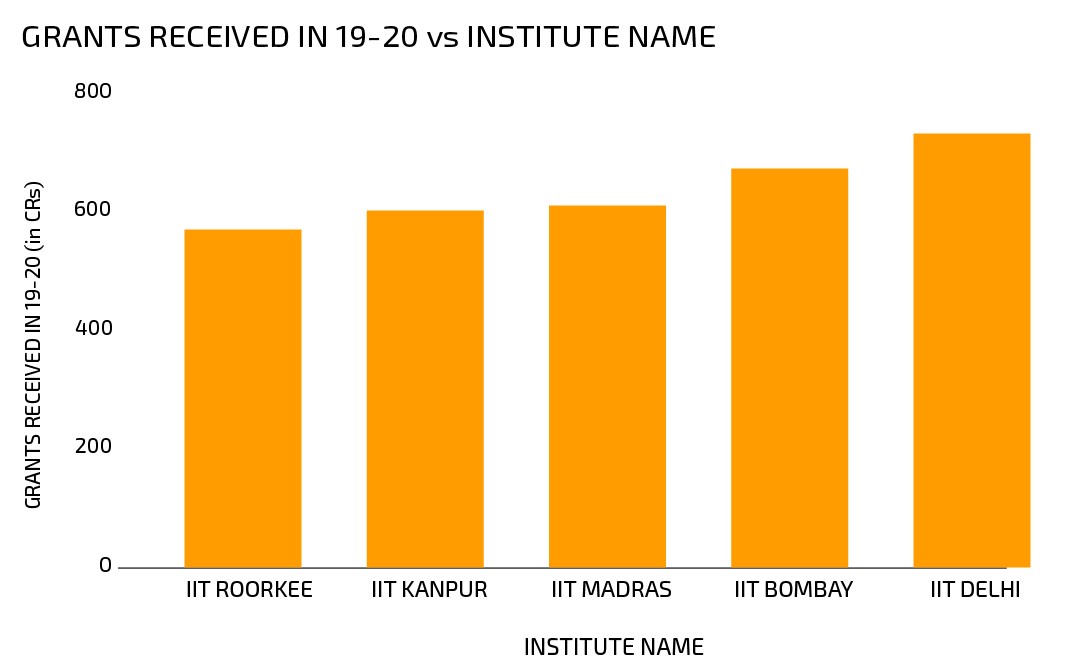
- More than 50% of the Central Government’s funds for Higher Education, in the last three years, go to students of IITs, IIMs and IIITs, which encompass just 3% (approximately) of the country’s students. These institutes are significantly more well funded than other institutes of the country.
- The reason for the IITs getting a lion’s share of the total grants was because of the hierarchical system that exists in the Indian education system where a majority of the state-funded universities have to run on self funding while universities like the IITs, which make it to the world rankings every year, get both fundings and attention from the central government.
- This results in a disproportionate concentration of research in these institutes, which leaves little to no scope for smaller universities to get big research grants.
- The second generation IITs like IIT-Hyderabad despite being in the top 10 of the NIRF Rankings for Engineering Colleges in India, find themselves lagging behind the older IITs in terms of funding, as said by the director of IIT-Hyderabad in an interview. Newer IITs tend to face problems related to their infrastructure as a lot of their labs require being set up from scratch. Moreover, newer IITs also tend to get less donations from their alumni because of the absence of a large alumni base.
- The criteria of the policy making revolving around budgetary allocation of educational institutions all around the world are indicative of the commoditization of education. It is a point of introspection that what parameters should truly control the access to state sponsored resources.
- This perception of Return-over-Investment philosophy is so deeply lodged within our psyche that it is observable in the metrics students restrict access to institute resources for themselves such as being a part of a club being solely linked with the tangible outputs produced by that group.
3. How the institute actually spends these grants.
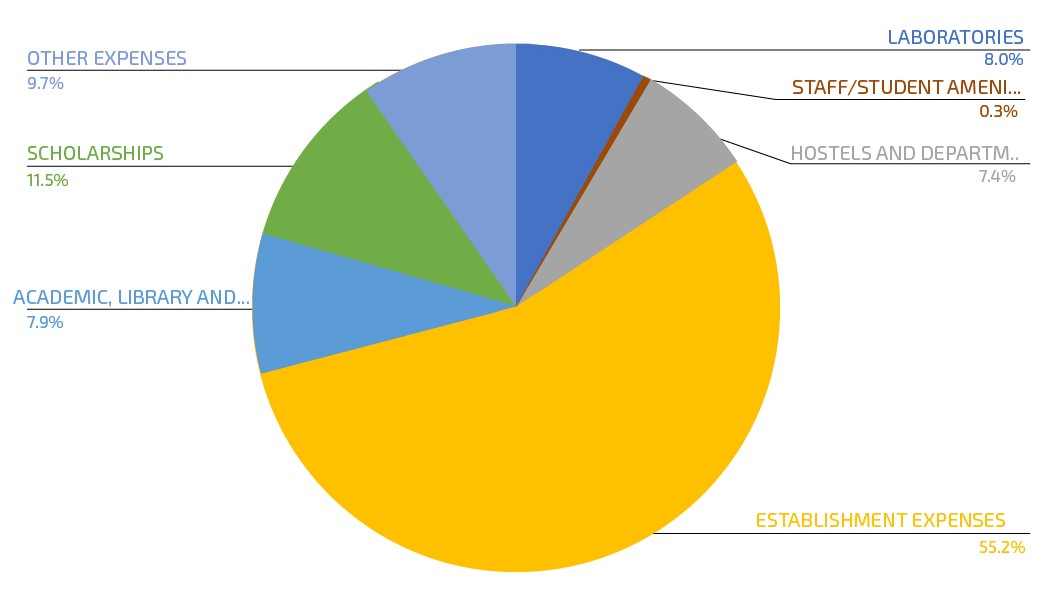
The majority of the expenses go to Establishment Expenses, followed by scholarships at 11.5% and Laboratories, Academic Library and Educational expenses, Hostel and Departments being roughly at around 8% each, while 11.5% of the grants are given out in the form of scholarships. These establishment expenses consist of various types of Employee Allowances, Pensions, and Security. A meagre 0.3% is spent on student amenities, which has a major scope for improvement. This segregation is more or less similar for all the top ranked IITs.
Section 2: Student to Professor Ratio
The student-faculty ratio refers to the number of students for every faculty in a university. This student-to-professor ratio is not an independent metric. While many factors contribute, it is determined by the UG and PG students’ size and whether all the faculty teach undergraduate classes. The lower this ratio, the more available are the professors for taking up queries posed by the students and collaborating in projects, The student-prof ratio reflects the faculty’s workload and how available they are to offer mentorship and care to their students. Many instances find that lower the number, better the educational process and learning because of students being able to perform better in the learning process. The student to professor ratio in Indian Universities is generally much higher than foreign universities.
1. Student to Professor Ratio in various departments of IIT Roorkee
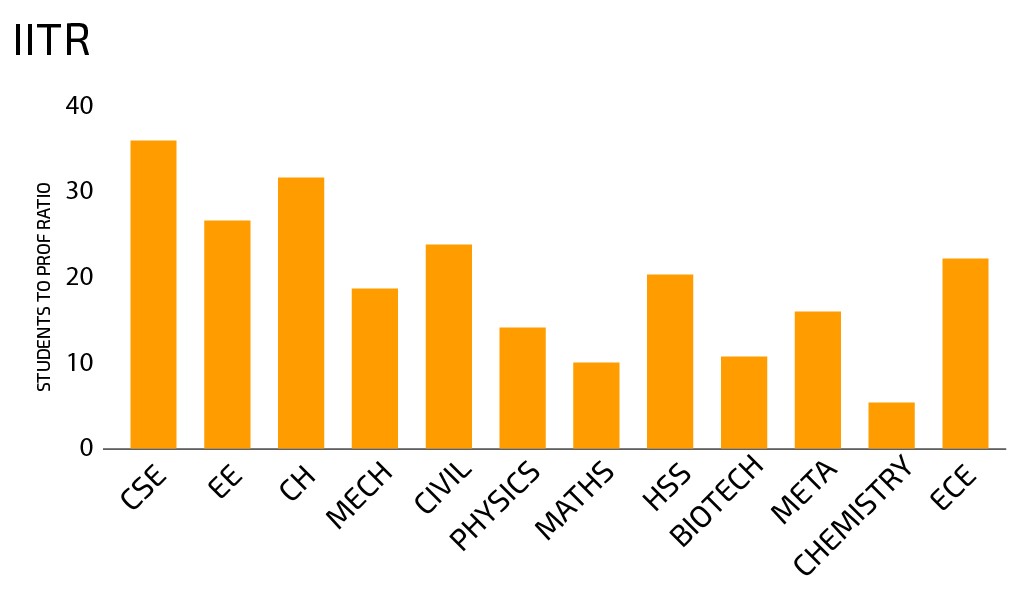
- Comparing the student-to-professor ratio in different departments of IIT-Roorkee, we find that the highest ratio is in Computer Science and Engineering (36.15), while the lowest is in Chemistry department (5.64).
- The ratio for the Civil department in IIT Roorkee is 23 which is 36% less than the CSE department. Surprisingly, the students’ size for CSE is 470, whereas, for Civil, it’s over 1000, much higher than CSE. The reason that makes the ratio so high for CSE is the small number of faculty available (only 13 faculties are there). For civil, the faculty strength is 47, which makes a huge difference.
- The average stuent-to-prof ratio in IIT Roorkee comes out to be 18.99 and out of the 12 mentioned departments, six departments (Mechanical, Physics, Chemistry, Metallurgy, Mathematics and Biotechnology) have an equal or lesser ratio than the overall average ratio.
2. Student to Professor Ratio in Roorkee vs the top ranked 3 IITs
The department-wise Student to Prof Ratio for IIT Roorkee, IIT Delhi, IIT Bombay, and IIT Madras for the year 2019-2020 is given here:
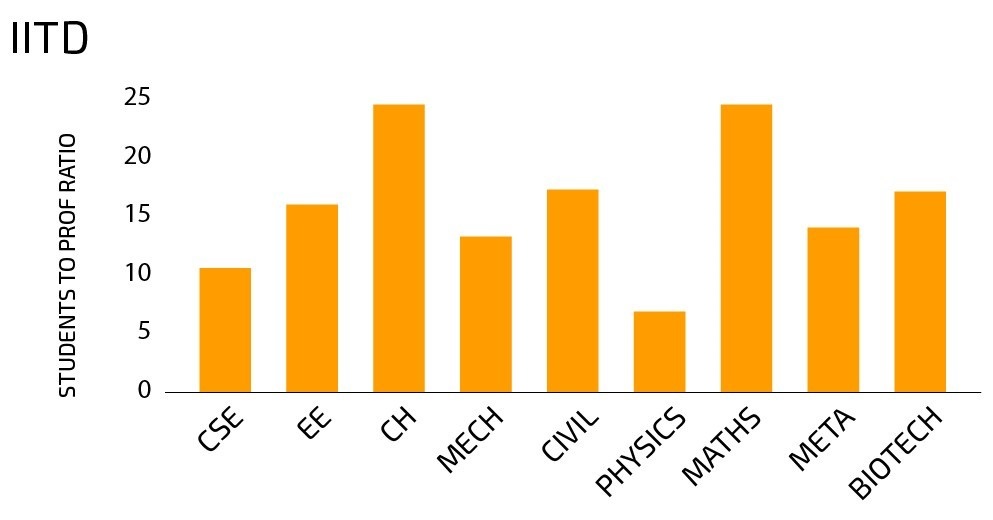
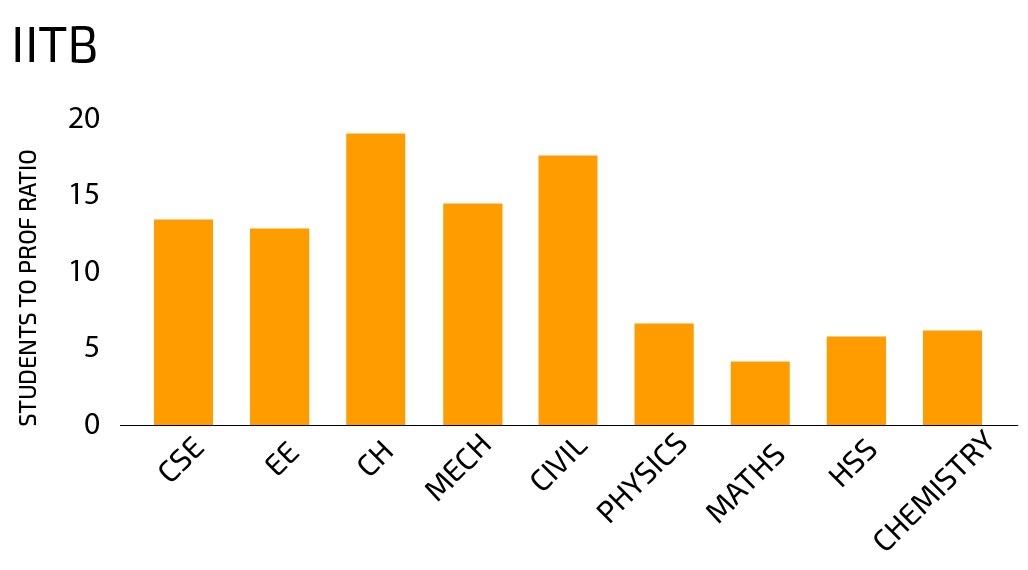
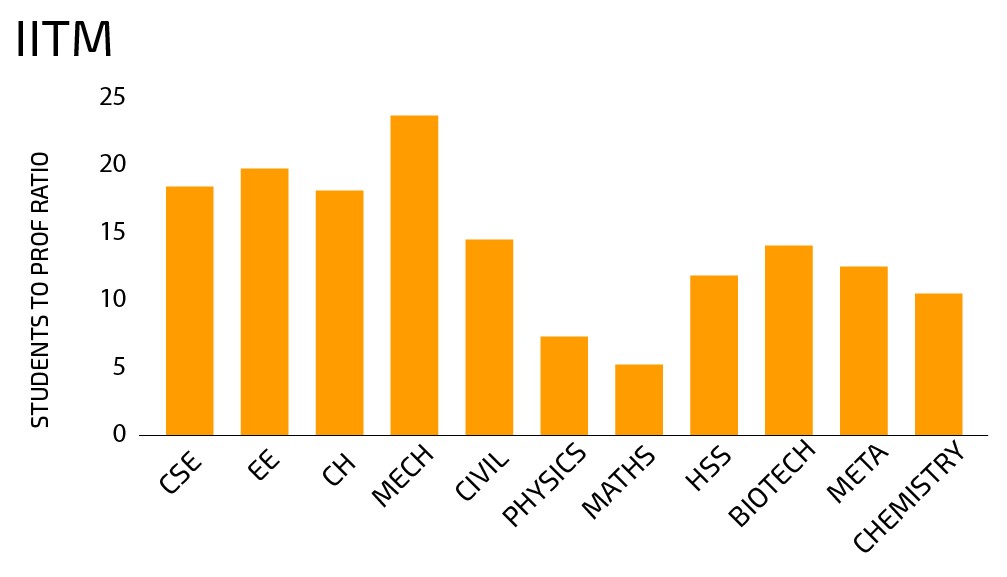
- It can be seen that the mechanical department in IIT Madras has a large student-to-prof ratio, it is due to the fact that the students’ size for a year in the mechanical department is over 1500 (including all batches of UG, PG). Although the size of students in the Electrical department is also around 1400, the high number of faculties in the department lowered the ratio.
- Some departments like chemistry, HSS, and physics have a meagre ratio in all institutes. The simple reason is that they don’t have many UG students. The department offers more Mtech and PhD courses.
- One department with a similar ratio across all institutes is the Chemical department. Though the number of students varies in each institute, the faculty strength counterbalances it.
3. Comparison of Overall Student to Professor Ratio in Roorkee vs Top Ranked 3 IITs
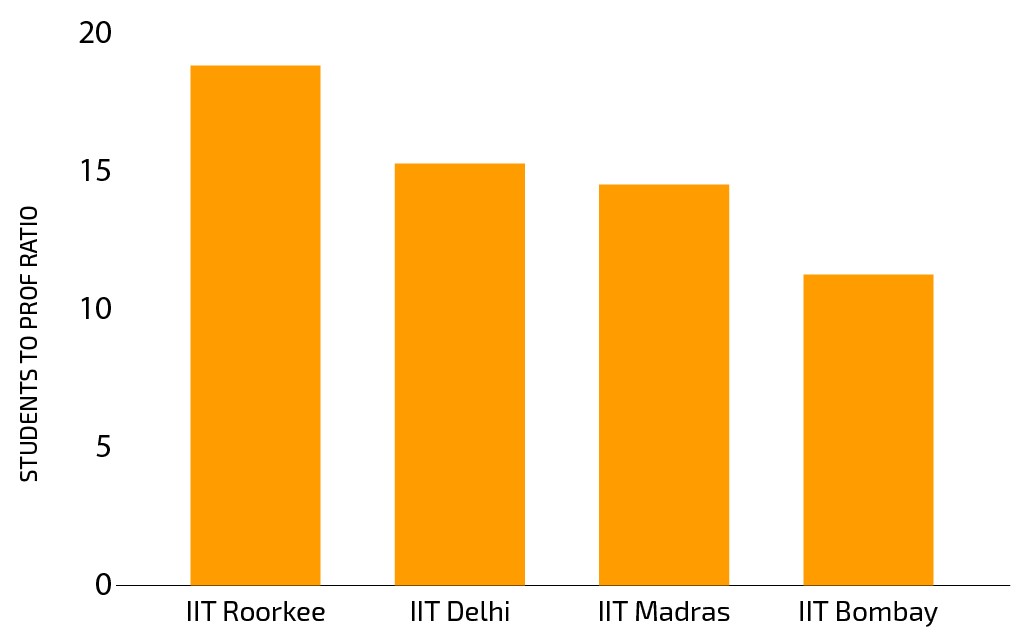
- The highest student to professor ratio is found in IIT Roorkee with 18.99 Students per professor, while the lowest ratio can be found in IIT Bombay having the ratio as 11.34.
- The Highest Number of Students are in IIT Madras with 7502 Students, but it has 514 professors which is also the highest among the IITs compared, Roorkee on the other hand has a higher ratio because the number of professors is 341, significantly lesser than IIT Madras.
- These numbers cannot be compared with other universities in India or even other engineering colleges, as IITs tend to have much better funding than any of the centre or state universities. However, comparison with engineering institutions in the USA can make us aware of our global standing. These institutions have a similar approach to education and R&D. Through various studies and surveys, the student-to-professor ratio was found to be approximately 6.066, compared to which IITs are not doing so great.
- Departments that have fewer undergraduate programs are able to lower their ratio, but the ones that offer bachelor’s degrees have a significantly higher ratio. Strict recruitment rules set by MHRD narrows the scope to find quality candidates especially in specialised streams.
Section 3: International Relations
1. Number of International Students admitted by program
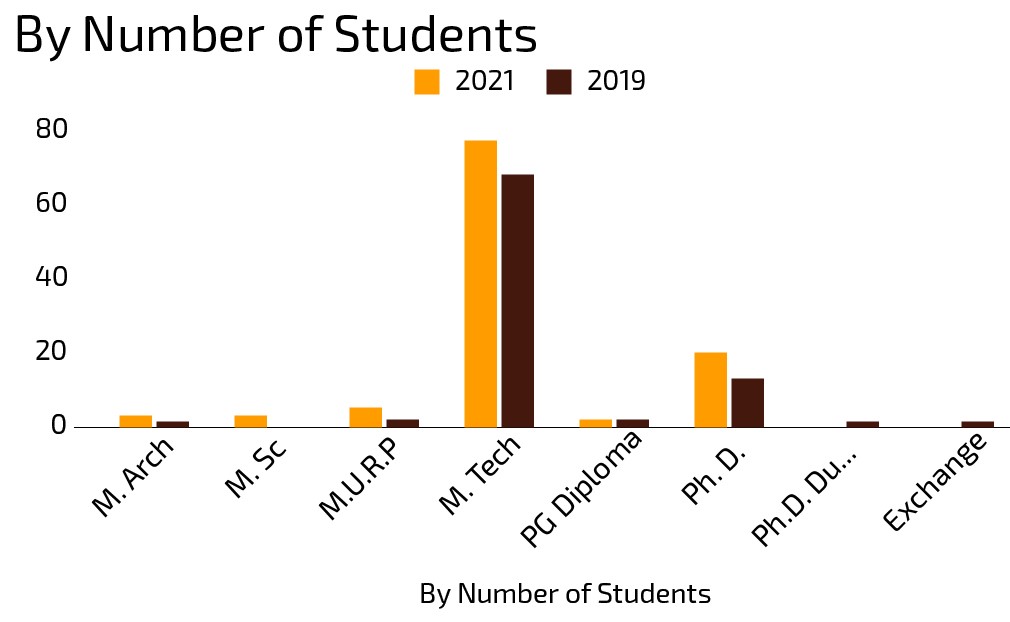
- The total number of international students at IIT-Roorkee has seen an upward trend over the years, with the number of international students increasing from just 97 in the year 2015-2016 to 219 students in the year 2020-2021. This number has seen a slight decline for the first time in 5 years, with the current number of international students being 202. This trend is most likely because of the COVID-19 Pandemic and the resulting travel bans which have discouraged students from pursuing international degrees across the globe.
- IIT Roorkee admitted 108 international students in the year 2020-2021 as compared to 88 students in the previous year.
- The Civil Engineering Department alone has 50 of the current 202 international students currently studying in the institute, followed by Electrical Engineering and Water Resource and Development Management with 22 and 16 international students respectively.
- Most of the current international students are admitted under two schemes offered by the Indian Government. They are
- Indian Council for Culture Relations(ICCR): Of the current 202 students, 78 of them have been admitted under this programme. This programme was started in the year 1950, by Maulana Abul Kalam Azad, independent India’s first Education Minister. Its objectives are to actively participate in the formulation and implementation of policies and programs pertaining to India’s external cultural relations.
- Study in India (SII): This program accounts for 46 of the current 202 students at IIT-Roorkee. This is a flagship program of the Ministry of Education (MOE), launched only in the year 2018. This program has the aim of endorsing India as a prime education hub for international students
- Students from Afghanistan have formed a significant chunk of our international students with 12 and 18 students from Afghanistan joining IIT-Roorkee in the last two years alone, this is because of greater collaboration between the Indian and Afghani governments. As a result, India has welcomed Afghani citizens seeking both good quality education and healthcare facilities. However it remains to be seen whether this trend will reverse itself because of prevailing precarious situations.
- IIT Roorkee has also hosted a lot of African students in the past few years, out of the 108 students admitted in 2020-2021, 46 of them were from African countries, with 20 being from Ethiopia alone.
2. Funding of IR Cell in FY 2019-2020
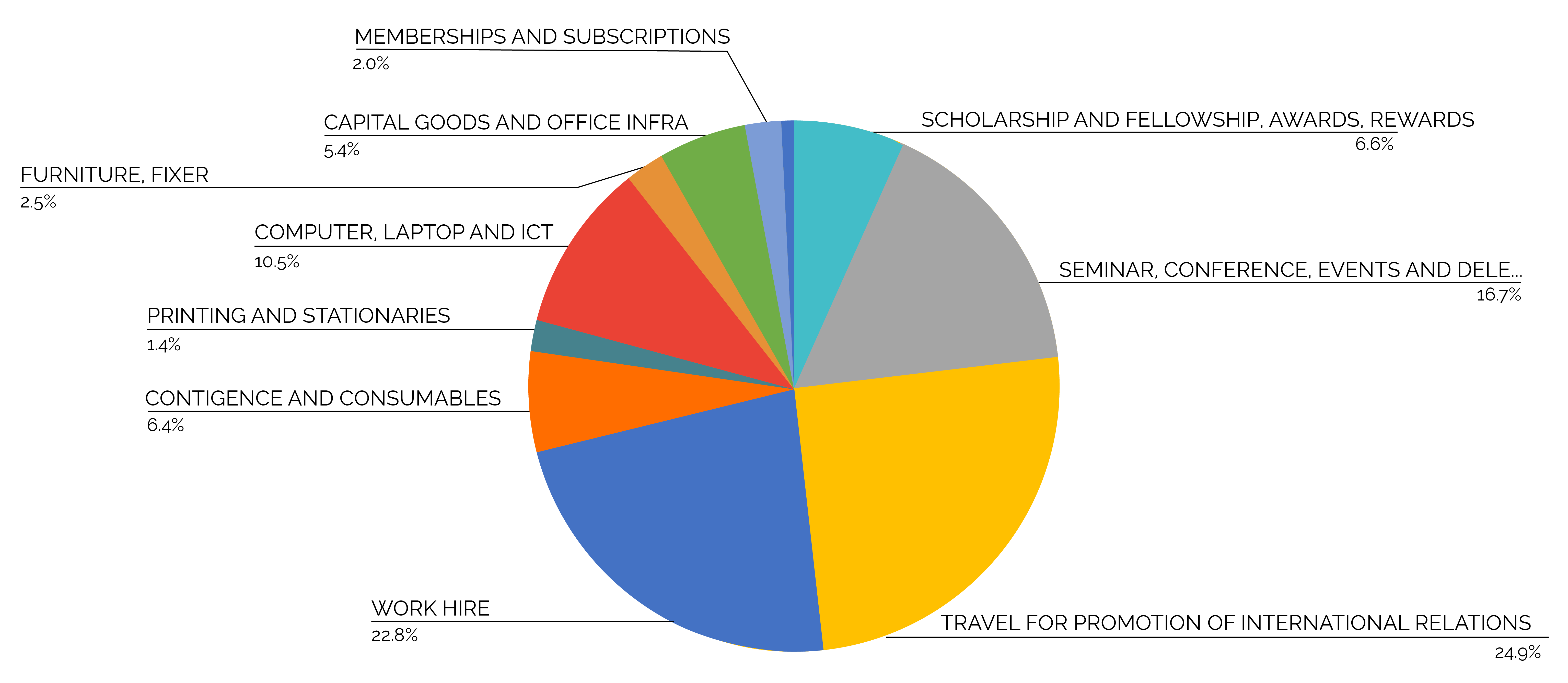
- The International Relations Promotional Account(IRPA) with an initial budget of Rs. 50 lakh was created in June 2019, its expenditures for FY 2019-2020 are as shown. The same grant was also issued for the year 2020-2021.
- In the year 2019-2020, the funds were majorly spent on travel for promotion of international relations ( 24.9%) and work hire (22.8%) as can be seen on the pie chart above.
- The trend shifted in the year 2020-2021 with almost 67.35% of the funds being spent on work hire followed by 12.01% of funds being spent on capital goods and infrastructure.
3. IIT Roorkee’s Standing in QS World University Ranking Indicator: International Students
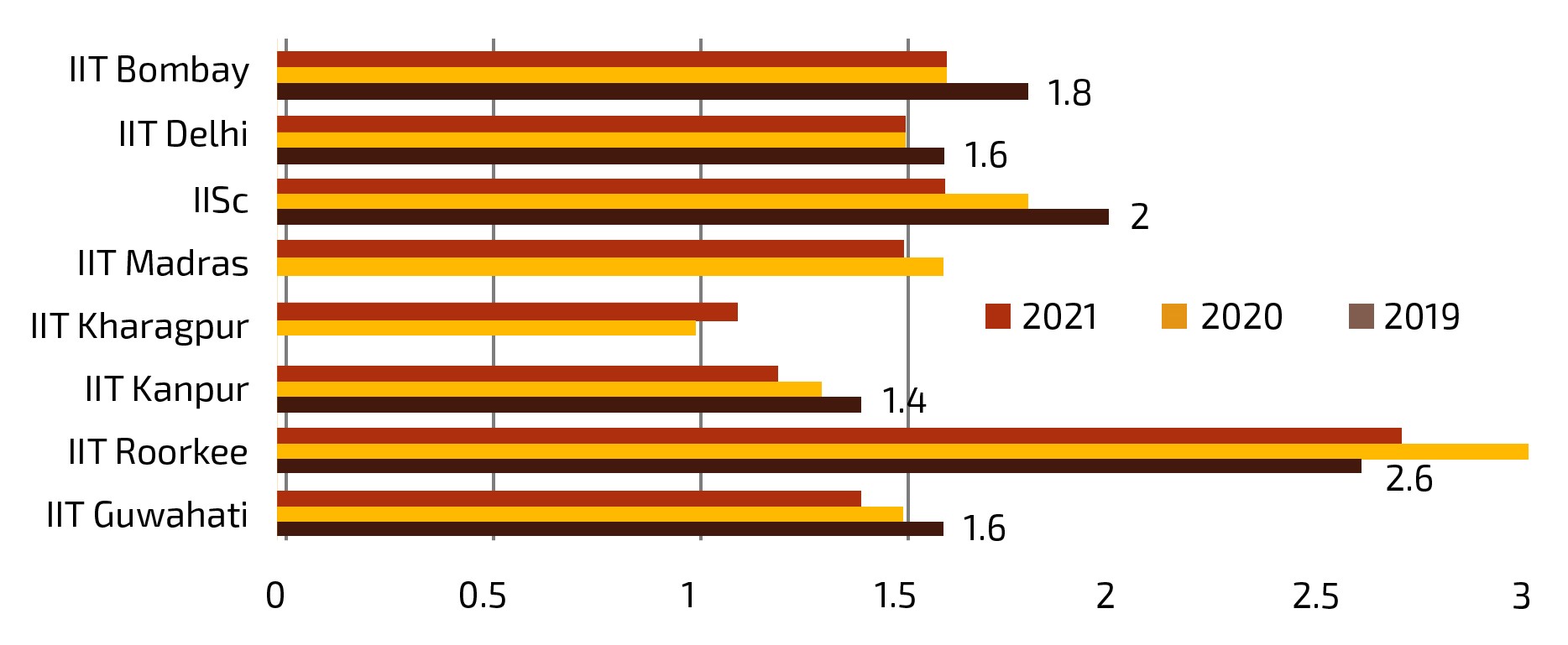
- A high performance in this particular metric of the QS World University rankings implies that the university has a tremendous global outlook. It demonstrates an ability to attract faculty and students from across the world. It also shows that these universities have a multinational environment, which facilitates a better exchange of ideas.
- In the QS World University Ranking Indicator for International Students, IIT Roorkee has a ratio of 2.6 which is the highest among the top ranked 5 IITs as can be seen in the graph.
- IIT Bombay which is the highest ranking Indian University on the overall QS University Rankings, has the international students ratio as 1.8 which is less than both IISc and IIT Roorkee.
- Among all Indian Universities, the best performing in this metric is Amity University which has this ratio as 20.7.
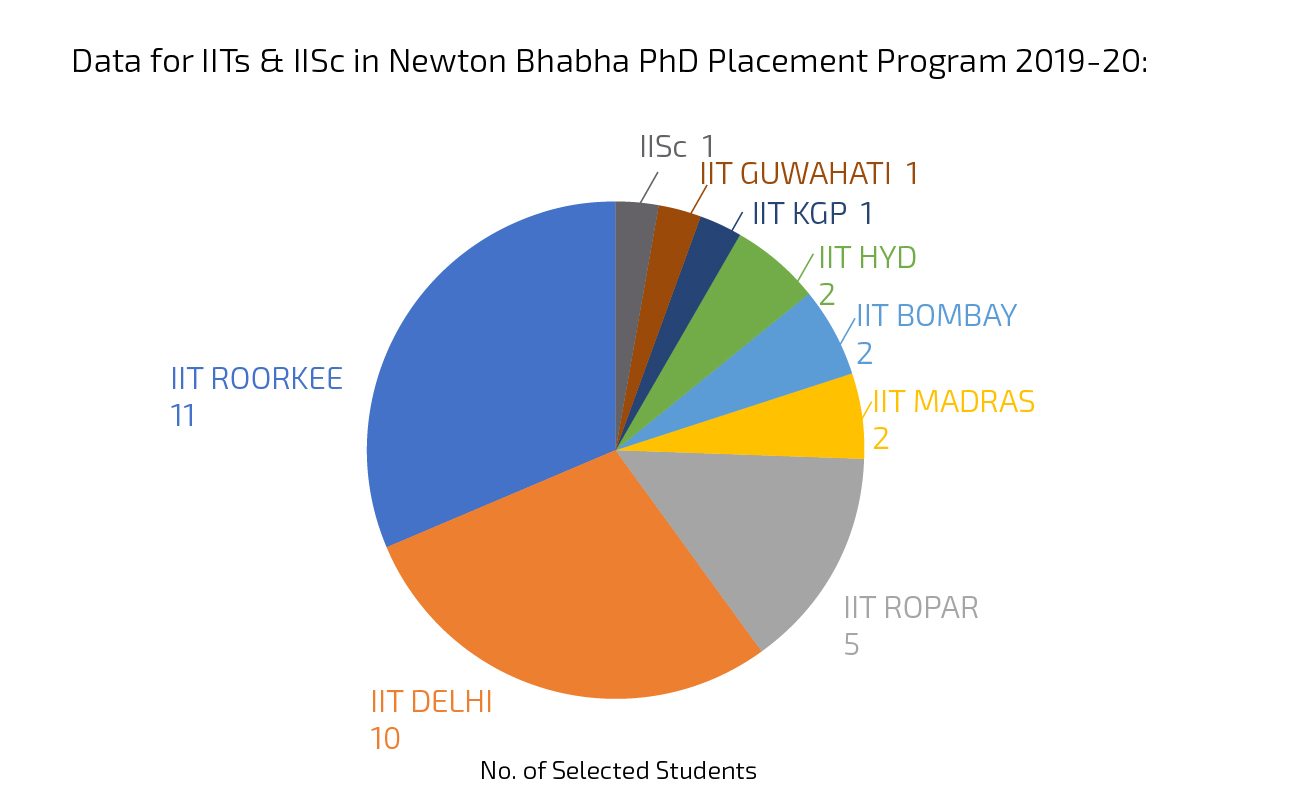
- The British Council India, the Department of Science and Technology (DST), the Department of Biotechnology (DBT) and Indian Higher Education Institutes (HEIs) sponsored the Newton Bhabha Fund to support short-term PhD placements between UK and Indian institutes
- The program has two main aims-
- To develop individual capacity through international training and development opportunities.
- To Increase the number of trained researchers in the UK and India to foster research and innovation in the two countries.
- 11 Students from IIT Roorkee were selected for this program in the year 2019-2020, which was the highest from any Indian University. This was followed by IIT Delhi with 10 students who qualified for the same.
Design credits: Nehal Chechani, Khushi Tomar, Amresh Gupta
